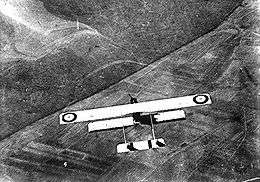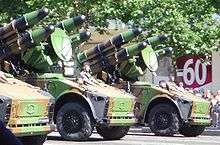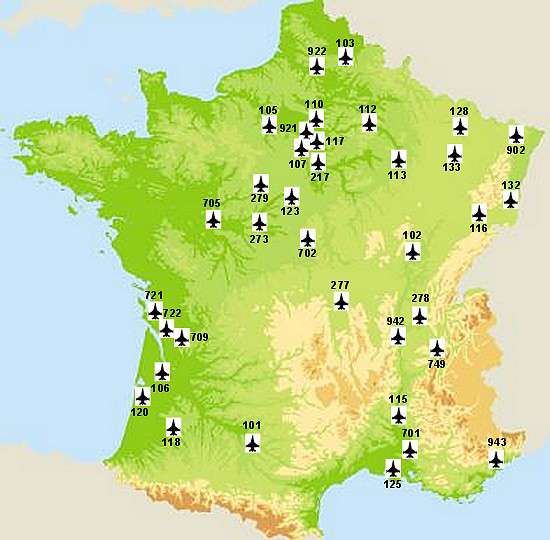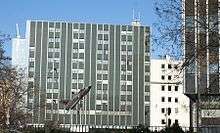The French Air Force (French: Armée de l'air [aʀme də lɛʀ], literally "air army") is the air force of the French Armed Forces. It was formed in 1909 as the Service Aéronautique, a service arm of the French Army, then was made an independent military arm in 1934. The number of aircraft in service with the French Air Force varies depending on source, however sources from the French Ministry of Defence give a figure of 658 aircraft in 2014.[7][8] The French Air Force has 247 combat aircraft in service, with the majority being 141 Dassault Mirage 2000 and 106 Dassault Rafale. As of early 2016, the French Air Force employs a total of 42,607 regular personnel. The reserve element of the air force consisted of 5,187 personnel of the Operational Reserve.[3]
The Minister of Defence is responsible for execution of military policy. He is advised by the Chief of Staff of the Armies (CEMA) in regard to the use of forces and the control of military operations. The Chief of Staff of the French Air Force (CEMAA) determines the air force doctrines and advises the CEMA how to deploy French air assets. He is responsible for the preparation and logistic support of the air force.
History

French aircraft flying over German held territory, 1915
The French took active interest in developing the air force from 1909 and had the first World War I fighter pilots. During the interwar years, however, particularly in the 1930s, the French Air force lost ground, both in numbers and quality to the Luftwaffe, which helped defeat the French during the Battle of France.
In the post–World War II era, the French made a successful effort to develop a domestic aircraft industry. Dassault Aviation led the way mainly with delta-wing designs, which formed the basis for the Mirage series of jet fighters. The Mirage demonstrated its abilities in the Six-Day War, Yom Kippur War, the Falklands War and the Gulf War, becoming one of the most popular jet fighters of its day, with a high quantity of sales. The French Air Force participated in several protracted colonial wars in Africa and French Indochina after the Second World War, and continues to employ its air power in Africa.
Beginning in January 1964, the French political leadership reprioritized its military emphasis on nuclear deterrence, implementing a complete reorganisation of the Air Force, with the creation of four air régions and seven major specialised commands, among which was the Strategic Air Forces Command (Commandement des forces aérienne stratégiques) (CoFAS).[9] The Military Air Transport Command had previously been formed in February 1962 from the Groupement d'Unités Aériennes Spécialisées. The Dassault Mirage IV, the principal French strategic bomber, was designed to strike Soviet positions as part of the French nuclear triad. Also created in 1964 was the Escadron des Fusiliers Commandos de l'Air (EFCA), seemingly grouping all FCA units.
In 1985, the Air Force had four major flying commands, the Strategic Air Forces Command, the Tactical Air Forces Command, the Military Air Transport Command, and the Commandement Air des Forces de Défense Aérienne (Air Command of Air Defence Forces).[10] CFAS had two squadrons of S-3 IRBMs at the Plateau d'Albion, six squadrons of Mirage IVAs (at Mont de Marsan, Cazaux, Orange, Istres, St Dizier, and EB 3/94 at Luxeuil), and three squadrons of C-135F, as well as a training/reconnaissance unit, CIFAS 328, at Bordeaux. The tactical air command included wings EC 3, EC 4, EC 7, EC 11, EC 13, and ER 33, with a total of 19 squadrons of Mirage III, Jaguars, two squadrons flying the Mirage 5F (EC 2/13 and EC 3/13, both at Colmar), and a squadron flying the Mirage F.1CR. CoTAM counted 28 squadrons, of which ten were fixed-wing transport squadrons, and the remainder helicopter and liaison squadrons, at least five of which were overseas. CAFDA numbered 14 squadrons mostly flying the Mirage F.1C. Two other commands had flying units, the Air Force Schools Command (CEAA), and the Air Force Transmissions Command, with four squadrons and three trials units.
In 1994 the Commandement des Fusiliers Commandos de l'Air was established.

Logo until 2010
The French Air Force is expanding and replacing aircraft inventory. The French are awaiting the A400M military transport aircraft, which is still in developmental stages, and the integration of the new Dassault Rafale multi-role jet fighter, whose first squadron of 20 aircraft became operational in 2006 at Saint-Dizier.
After an absence lasting several decades, the French President Nicolas Sarkozy confirmed that France will rejoin the NATO integrated command.[11] France has also been a lead nation, alongside the United States, Great Britain and Italy in implementing the UN sponsored no-fly zone in Libya (NATO Odyssey Dawn), deploying 20 fighter aircraft to Benghazi in defense of rebel held positions and the civilian population.[12]
From 2008-2010 the Air Force underwent an organisational streamlining process. This project was called Air 2010, which was the year of the deadline for all transitions. The main targets of this project were to simplify the command structure, to regroup all military and civil air force functions and to rationalise and optimise all air force units. Five major commands, were formed, instead of the former 13, and to disband several commands and units.[13]
- CDAOA (air defence and air operations command)
- CFA (air force command)
- CSFA (logistic command)
- DRHAA (human resource direction)
- SAGF (administration and finance service)
The last remaining squadron of Dassault Mirage F1s were retired in July 2014 and replaced by the Rafale.
Structure

Riflemen of the French Air Force
The Chief of Staff of the French Air Force (CEMAA) determines air force doctrine and advises the Chief of the Defence Staff how to deploy French air assets. He is responsible for the preparation and logistic support of the air force. The CEMAA is assisted by the air force staff and by its subordinate services. Finally, the CEMAA is assisted by the inspection of the air force (IAA) and by the air force health service inspection (ISSAA).
Higher commands

Crotale missile-launchers of the French Air Force
The Air Force's responsibilities are separated in two main types of commands: operational commands (direct responsible for force deployment) and organic commands (in charge of conditioning and logistic support).
- Strategic Air Forces Command
This command controls all the air force's nuclear assets, and is responsible for the operational condition and the eventual deployment of these weapons.[14] The CFAS commanding general is Général de corps aérien Patrick Charaix. The CFAS is one of the two pillars of the French nuclear deterrent. CFAS has two squadrons of dual capable aircraft, one of Mirage 2000N fighter/bombers capable of carrying the nuclear Air-Sol Moyenne Portée stand-off missile (EC 2/4 at Istres Le Tube), one of Rafales (EC 1/91 Gascogne at Saint-Dizier – Robinson Air Base) and a squadron of C-135FR in-flight refueling tankers.
- Air Defence and Air Operations Command (CDAOA)
This overall command is responsible for all air operations in peacetime serving the public, for the defence of the French airspace and for all offensive and defensive air operations at war. CDAOA, based in Paris and Lyon, plans and executes all air operations. Former Commandement air des systèmes de surveillance, d'informations et de communication (CASSIC) personnel are embedded here to develop exercises and operations abroad.
- Command of Air Forces (CFA)
A new command which was inaugurated in 2006. Its headquarters is at Metz. It is responsible for ensuring and to maintain the operational condition of all branches of the air force now and for the future. Today the CFA consists of 16 fighter, 25 air defence squadrons, one electronic warfare squadron, and simulator and instruction centres. At its airbases in Europe and abroad the CFA has 16,000 personnel, 246 fighter aircraft, 111 transport aircraft and 83 helicopters.
The command is divided into:
- Brigade aérienne de l'aviation de chasse (BAAC, the Air Brigade of Fighter Aviation) which is responsible for all conventional combat and air defence aircraft, d'assaut et de reconnaissance (Rafale, Mirage 2000-5F, Mirage 2000B/C/D, Mirage F1-CR, Mirage F1-CT, Transall Gabriel). This brigade was the former Command of Combat Air Forces (CFAC).
- Brigade aérienne d'appui et de projection (BAAP, the Air Brigade of Assistance and Projection) which is responsible for all transport and liaison aircraft (Transall C-160, Hercules C-130, A310/319, Falcon 50/900, Puma, Fennec, Cougar, TBM700 etc.).
- Brigade aérienne de contrôle de l'espace (BACE, the Air Brigade of Space Control), which is responsible for the airborne means (AWACS E-3F) and land means (ground-based radars, systèmes de défense sol-air and antimissile, communications networks) of airspace surveillance. Since 2007 information networks are under control of the Joint Directorate of Infrastructure Networks and Information Systems (DIRISI), the interim joint defence communication and intelligence organisation. Since 2007, 38% ex-CASSIC personnel have joined the brigade, which also controls all ground-based air defence units.
- Brigade aérienne des forces de sécurité et d'intervention (BAFSI). This was the former CFPSAA, the Security and Protection Forces Command, renamed in 2007.[15] This command was responsible for the operational readiness and the deployment of all base protecting squadrons, dog-handlers, fire brigades, paratroopers and NBC and decontamination personnel. In 2007, the CFPSAA was renamed BAFSI (Brigade Aérienne des Forces de Sécurité et d'Intervention).
Circa 2013 the CFA and the former commandement du soutien de la force aérienne (CSFA) merged.[16] CSFA, based in Bordeaux, directed the technical and logistical assets. Since 2006 it had taken over many ex-CASSIC projects.
Wings (escadres), which were dissolved from 1993 as part of the Armées 2000 reorganisation, were reestablished in 2014.[17] The problems caused by having the aircraft maintenance units not responsible to the flying squadrons they supported eventually forced the change.
Four wings were reformed in the first phase:[17]
- the 31st Strategic Transport and Air Refuelling Wing (31e escadre aérienne de ravitaillement et de transport stratégiques) at Istres-Le Tubé Air Base on 27 August 2014;
- the 36th Airborne Command and Control Wing (36e escadre de commandement et de conduite aéroportée) at Avord Air Base on 5 September 2014;
- l'escadre sol-air de défense aérienne - 1er régiment d'artillerie de l'air (ESADA - 1er RAA) sur la Avord Air Base (3 septembre 2014) ;
- the 3rd Fighter Wing sur la Nancy-Ochey Air Base (5 September 2014)
In the second phase, the Air Force announced in August 2015 the creation of seven additional wings :[17]
The Air Force also announced in August 2015 que la numérotation des unités, l’immatriculation des aéronefs affectés et le transfert du patrimoine historique (drapeau, traditions et nom de baptême) seraient mis en conformité avec leurs escadres d’appartenance au cours de 2016.[17]
- Air Force Training Command
French: Commandement des Écoles de l'Armée de l'Air (CEAA). Responsible for training all new air force personnel as well as on the technical and on the job training of the other air force personnel, as well as the officers and NCO training. CEAA is also responsible for all schools and training facilities.
Airbases
The air base command levels are the combat assets of the ALA. An airbase commander has authority over all units stationed on his base. Depending on the units tasks this means that he is responsible for approximately 600 to 2500 personnel.
Flying activity in France is carried out by a network of bases, platforms and French air defence radar systems. It is supported by bases, which are supervised and maintained by staff, centres of operations, warehouses, workshops, and schools.
Both in France and abroad, bases have almost similar infrastructure to provide standardised support. This operational mode allows fast and easy creation of air bases outside France.
Overseas, fighters, transport aircraft and helicopters allow quick response to any request for assistance that falls within international agreements. On average, a base platform, made up of about 1500 personnel (nearly 3500 people including family), provides a yearly economic boost to its area of about 60 million euros. Consequently, determining the sites for air bases constitutes a major part of regional planning.
[18]
Bases

Air bases in Metropolitan France
Northern region

BA117 Paris, HQ of the French Air Force
Two bases have recently been closed; DA 922 Doullens air detachment, a disbanded command reporting centre, and Taverny Air Base, the former Strategic Air Forces Command headquarters.
Southern Region
Overseas
Equipment
Aircraft inventory
Ranks
| Flag officers |
|---|
| général d'armée aérienne
(air army general) |
| général de corps aérien
(air corps general) |
| général de division aérienne
(air divisional general) |
| général de brigade aérienne
(air brigade general) |
|
| Officers |
|---|
| sous-lieutenant
(sub-lieutenant) |
| aspirant
(officer candidate) |
|
| Student |
|---|
| aspirant élève de l'École de l'air (EA)
(officer candidate, air force academy) |
| aspirant élève de l'École militaire de l'air (EMA)
(officer candidate, military flight school) |
| élève officier de l'École de l'air (EA)
(officer cadet, air force academy) |
| Elève officier du personnel navigant (EOPN)
(navigation officer cadet) |
|
| Non-commissioned officers |
|---|
| adjudant-chef
(chief adjutant) |
| sergent-chef
(chief sergeant) |
|
| Enlisted personnel |
|---|
| caporal-chef
(chief corporal) |
| aviateur de première classe
(aviator first class) |
| aviateur de deuxième classe
(aviator second class) |
|
See also
References
Further reading
- Olivier, Jean-Marc, (ed.), Histoire de l'armée de l'air et des forces aériennes françaises du XVIIIe siècle à nos jours" [History of the French Air Force since the 18th century to the present], Toulouse, Privat, 2014, 552 p.
- Pither, Tony (1998). The Boeing 707 720 and C-135. England: Air-Britain (Historians) Ltd. ISBN 0-85130-236-X.
- Thomas-Durell Young, Command in NATO After the Cold War: Alliance, National and Multinational Considerations, U.S. Army Strategic Studies Institute, June 1997
External links
|
|---|
|
| Sovereign states | |
- Austria
- Belgium
- Bulgaria
- Croatia
- Cyprus
- Czech Republic
- Denmark
- Estonia
- Finland
- France
- Germany
- Greece
- Hungary
- Republic of Ireland
- Italy
- Latvia
- Lithuania
- Luxembourg
- Malta
- Netherlands
- Poland
- Portugal
- Romania
- Slovakia
- Slovenia
- Spain
- Sweden
- United Kingdom
|
|---|
| Other |
- Albania
- Andorra
- Armenia
- Azerbaijan
- Belarus
- Bosnia and Herzegovina
- Georgia
- Iceland
- Kazakhstan
- Liechtenstein
- Republic of Macedonia
- Moldova
- Monaco
- Montenegro
- Norway
- Russia
- San Marino
- Serbia
- Switzerland
- Turkey
- Ukraine
|
|---|
|
|---|
|
|
- Abkhazia
- Kosovo
- Nagorno-Karabakh
- Northern Cyprus
- South Ossetia
- Transnistria
|
|---|
.svg.png)







_of_the_French_Air_Force_arrives_Fairford_7Jul2016_arp.jpg)























